CAR SEAT

SEAT TYPES EXPLAINED
SMARTER
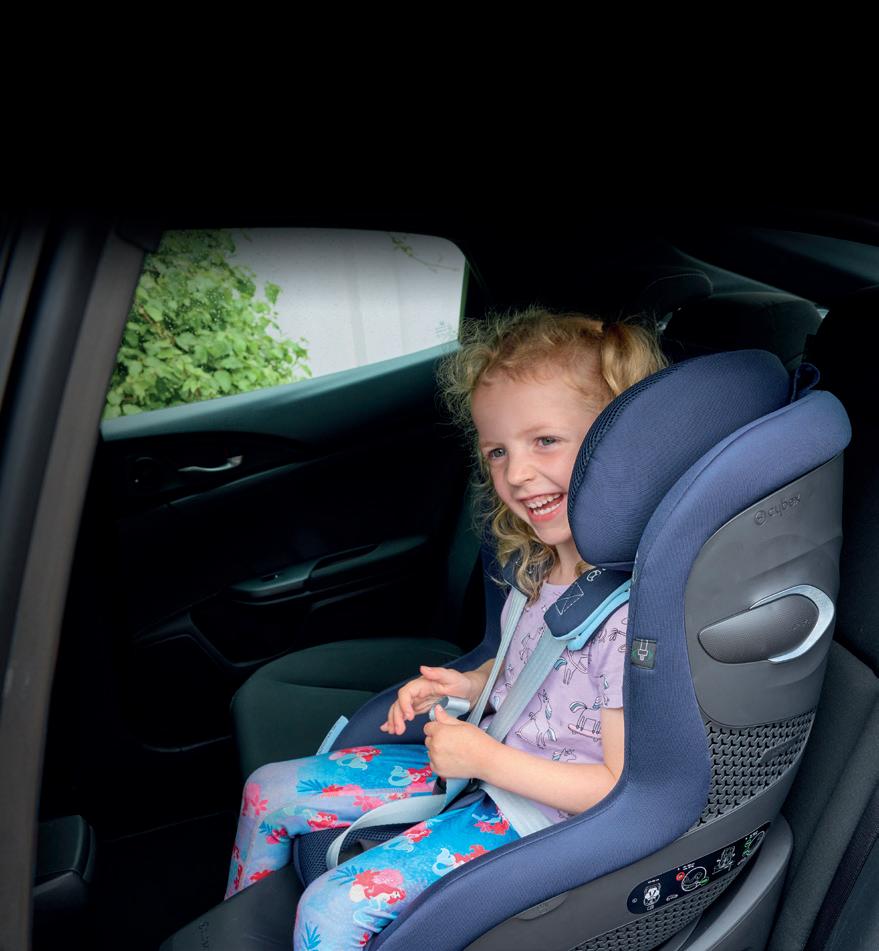
Essential seat maintenance tips
Top tips to keep children safe on every journey
PLUS!
BUYING How to pick the right seat for your needs
FITTING
Make sure your seats are installed correctly
THE LAW
All of the rules and regulations explained
THE COMPLETE GUIDE TO SAFELY TRANSPORTING CHILDREN
In association with
WELCOME
When you’re driving you won’t carry a more precious cargo than your children, or somebody else’s. To keep them safe you must transport them in some sort of seat, but knowing where to start can be really confusing – there’s just so much to consider. That’s where this booklet comes in – it will guide you through the different types of seat, how to fit one properly and how to look after it.
LEGAL REQUIREMENTS
The law refers to using an appropriate child seat. All seats will display what height/weight and age of child they’re suitable for, so check it’s the right one and don’t risk it.
● For children under three a correct child seat must be used in the front and back of the car.
● Children aged 3-12, or under 135cm tall, must be in a correct child seat in the front of the car, and in the back where a seatbelt is fitted.
● Children over the age of 12 or taller than 135cm must wear a vehicle seatbelt.

IT’S AFACT
An unrestrained child can be killed in an impact at a speed as low as 5mph
2 carseatsmarter.co.uk PARENTS GUIDE
Notallchildseats arelegaltouse intheUK

SETTING THE STANDARD
Child seats must conform to one of three European standards, so if yours doesn’t have one of these marked on it, it isn’t legal to use in the UK.
Regulation 129
This is the newest standard designed to make child seats safer and easier to use correctly. These seats are designed around a child’s height rather than their weight, tested using modern technology, and must have been side-impact tested.


This standard of seat is still being sold in the UK. However, it won’t be sold in Europe from September 2024. Many large retailers in the UK also won’t be selling this standard of seat. Seats that meet this standard have been tested to a certain level.
DID YOU KNOW?
● Collecting another child as a favour isn’t classed as an unexpected necessity. So check if they need a seat and ensure you can provide an appropriate one.
● Don’t leave children in the car even if they’re asleep. Lock the car and it could set the alarm off; leave it unlocked and your car could be stolen with your child inside. Leave your keys in the car and your child could lock themselves in or start the engine.
● It’s the driver’s responsibility to ensure all passengers aged 14 and under are using the correct child seat or seatbelt. See rule 99 of the Highway Code for more (highwaycode. info/rule/99).
● Since 9 February 2017 manufacturers haven’t been allowed to design new backless booster cushions for children shorter than 125cm and weighing less than 22kg, as they don’t offer any upper body or head protection.
THE PENALTIES
This standard of seat hasn’t been sold since 2006, so while such seats are still legal, if you have one think about how old and worn it is.
Break the law and you could receive a £100 fine. If dealt with by the court this could be more. Crash while carrying an incorrectly restrained child and the outcome could result in death or injury of the child.
3 carseatsmarter.co.uk
IT’SA FACT
ECE R44.03
ECE R44.04
5
1
THE 3
TYPES OF
Child seats can be put into five groups, and it’s essential that
REAR-FACING & HARNESSED FOR LONGER 2
NEWBORN SEATS
Keep your baby rear-facing until they’re at least 15 months old to ensure they get the best protection for their head, neck and spine and many seats have new-born inserts to help with this.
Many seats allow you to keep your child rear-facing longer than a traditional infant carrier seat would. Some can accommodate a child who is six or seven years old. Some harnesses have a maximum weight load of 25kg, which
ONE SIZE FITS ALL
should take your child to around six years of age. If your little one is big for their age, you may benefit from having a seat like this to allow their bones time to strengthen without compromising their protection.
Some manufacturers have developed one seat that will cover all your child’s growth development from birth right through to 150cm tall, which is about 12 years old. These seats
are adjustable and “grow” with your child. But always make sure it fits your car in all its stages before you buy, or you could be putting your child at risk.
4 carseatsmarter.co.uk PARENTS GUIDE
CHILD SEAT
you buy the right one for your child’s needs.
5
BOOSTER SEATS USING THE VEHICLE SEAT BELT
In a side impact collision a booster cushion offers no upper body protection for your child, so a highbacked booster seat is a far better alternative. Designed for older children who need to be raised up so the adult seatbelt is correctly positioned. These seats don’t have a harness as the child is secured with the adult seatbelt. Most seats of this type feature an adjustable headrest, while
some have an adjustable width or leg rest so that growing children can get comfortable. These seats are lightweight and easy to fit, so can easily be transferred between cars. Some of these seats can be installed via the ISOFix points, but many are retained by the car’s seat belts. Check that the vehicle’s seatbelt sits correctly on their shoulder and not across their neck.
4 MULTIPLE SIZE SEATS
Some seats can cover a range of heights and weights. These seats are great if you need to transport children of different ages, such as grandchildren, as they can be altered to fit each one. Look for those seats that are quick to adjust to fit each child, because you will have to do this every time to give them the correct protection for their stage of development.
5 carseatsmarter.co.uk
SHOPPING FOR A T
o ensure you’re fitting your child seat correctly, always buy it from a retailer who can show you how it fits and if it’s compatible with your car. Never buy a child seat as an impulse purchase. Spend time with the retailer to go through your requirements. To find the correct seat, answer these questions:
● What is the height, weight and age of your child?
● How many other passengers do you regularly or occasionally need to transport?
● What is the make, model and year of the car(s) you drive? Look at the vehicle handbook for compatible seating positions, airbags, etc.
● Have the vehicle seats been modified and are they suitable for travel or leisure use only?
● Does your car(s) have ISOFix, underfloor storage, tether points or removable head restraints?
Using a compatibility list provided by the seat manufacturers, the retailer will check that the child seats you’re interested in are appropriate for your car. When you’ve selected the seat they can show you how to
IT’SA FACT
37% of children are in the wrong type of seat for their age and/or height


properly install it and how to put your child into it correctly. If the retailer doesn’t make these checks, ask them to, or go elsewhere.
It’s worth getting to know your local child seat specialist because while buying a child seat online can save time and money, you won’t get specific guidance on the right seat for
your child, or help physically fitting it which is vital. Good retailers are also happy for you to return if you get a new car or as your child grows and the seat needs altering.
The recommended height/ weight/age of many seats often overlap between the smaller and bigger sizes, so it can be tempting to move
6 carseatsmarter.co.uk PARENTS GUIDE

CAR SEAT
IT’SAFACT
Child seats can seem expensive, but when you break the cost down into weekly amounts based on how long your child will use it for, it can be as little as 50p a week. That’s a small price to pay for your child’s safety.
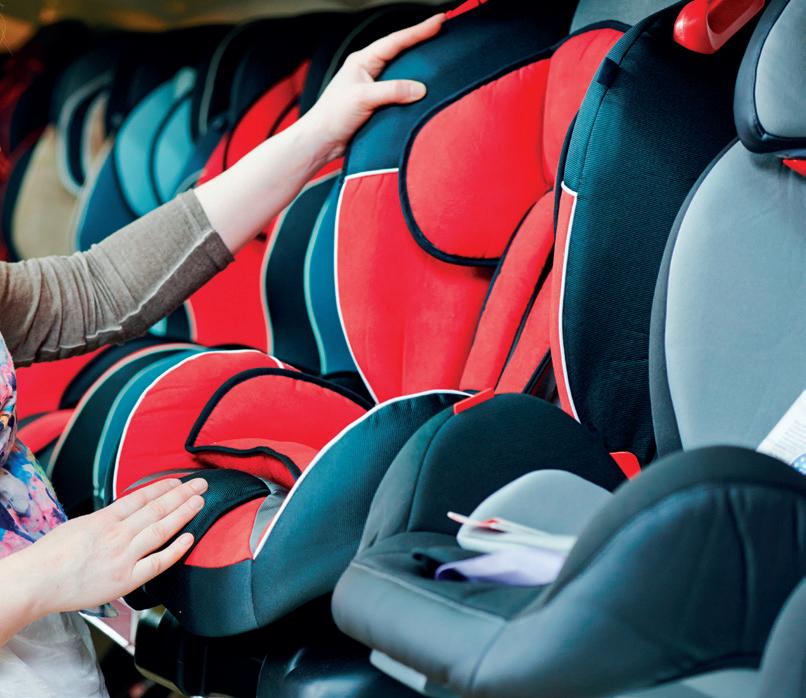
When buying a new seat, bear in mind how big your child will grow.
them up to a bigger seat early. But this can be less safe for your child, so use their existing seat for as long as possible while they are within the specified height/weight limit of the seat.
When buying a new seat, bear in mind how big your child will grow. While they may fit it now, they could be
big for their age and soon grow out of it. It’s difficult to imagine your 18-month old toddler as a 10-year old, but many seats can fit both sizes of child, so consider a seat which expands, stretches and has an extended harness weight, as it’ll fit your child better as they grow and save you money in the long run.
7 carseatsmarter.co.uk
HOW TO
There are lots of different ways to fit child seats, so follow the instructions provided with the seat –they’re also printed on the side of the seat. These tips will help you get it right:
● Seats fitted using a vehicle’s seatbelt have coloured guides to help you fit them. Recent seats have green guides, on older seats you will have blue or red guides.
● ISOFix seats have a green indicator which will display to tell you that it has been fitted correctly.
● Some seats have an audible sound if they’re not fitted correctly. Don’t just rely on this in case the batteries have run out.
● If correctly fitted, a child seat secured by a seatbelt will work just as well in a crash as one retained by ISOFix.
● In addition to a child seat, buckle guards and chest locks may be needed for children with special needs to ensure they’re securely fastened.
When rear facing their head must be completely inside the seat for maximum protection
FIT A CHILD
● For rear-facing seats the harness should be on the shoulder or just below it. For forward-facing seats the harness should be on the shoulder or just above it.
● Pull the harness tight to stop your child being able to wriggle their arms out and undo the buckle. The best way to check if it’s tight enough is to do the pinch test, which means you shouldn’t be able to pinch the harness together.
● What your child is wearing can affect how much tighter the harness needs to be. It needs to be as close to the skin as possible to give the maximum protection, so no thick jumpers or winter coats. Consider using a blanket over the harness instead, to keep them warm.
● If you’re using an infant carrier for your newborn, keep the amount of time they’re in the seat to a minimum and certainly no longer than two hours at a time, especially in their first few months. If you’re making long journeys take regular breaks and take your baby out of the seat.
● If their feet are sticking out of the end of their child seat, your baby hasn’t necessarily outgrown it. Their head must be completely inside the seat for maximum protection. Don’t turn them around until they’re at least 15 months old.

TOPTIP
childrenThesafestplacefor12andunderisin sittherearseats.Ifachildmust inthefront,theseatshould bemovedasfarbackfromthe dashboardaspossibleand thechildshouldusethe appropriatechildseat fortheirheightand weight.
8 carseatsmarter.co.uk PARENTS GUIDE
CHILD SEAT

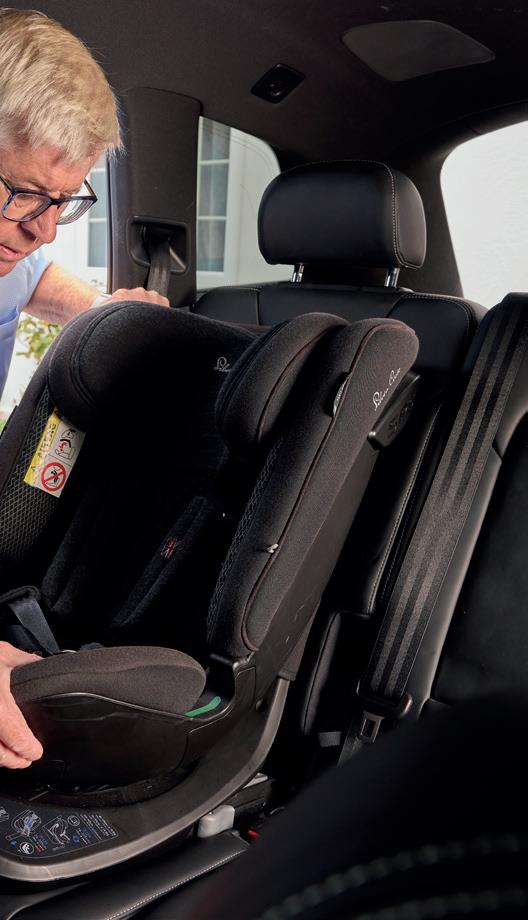
READ THE MANUAL
Volkswagen and Britax developed the ISOFix system in the late 1990s, as a way of securely installing a child seat rather than relying on a seatbelt. The seat is attached directly to the car’s structure; the ISOFix points are located where you see the label on the vehicle seat.
Before trying to fit a child seat into any car, read the vehicle’s manual. This will provide a lot of useful information about using a child seat, such as:
● where the ISOFix points are
● where to find the tether points
● which seats can be used for a child seat
● which child seats were actually crash tested in your vehicle
● when and how to turn the airbag off
● how to remove the head restraints.

HIGH BACKED SEATS & BOOSTER CUSHIONS
TOPTIP
If you need to fit three seats in the rear, make sure you can slide your hand between each one and the doors. If you can’t do this, use the front passenger seat for the oldest child.
Always use a booster seat with a full back. This will help protect your child’s upper body, neck, spine and head, unlike a booster cushion. This is especially true if you’re involved in a side-impact collision. Although a child of 135cm and above can legally travel without using a child seat in the UK, these seats are designed to last until they’re 150cm tall; it’s much safer for them to continue using it. Their seatbelt must sit on their shoulder and not across their face and neck.
9 carseatsmarter.co.uk
ISOFix
IT’SA FACT
rear-facingKeepingyourchildforaslongas possiblehelpsprotect theirveryweakhead, neckandspine.
PLAY IT SAFE
Turn the safety levels up to 10 with these top tips

AIRBAGS BELT BUCKLES HEAD RESTRAINTS
You must never put a rearward facing child seat on the front passenger seat with an airbag without first deactivating the airbag. You can normally do this with the ignition key. Some vehicles also have side airbags that inflate from the side of the seats. Don’t have the child seat leaning against the car door as it will need room to move if the airbags are deployed.
Buckle Crunch is where the buckle of the vehicle seatbelt is bent on or over the child seat. During an impact, this puts pressure on the buckle which could fail and release the seat. This usually happens when the seatbelt buckles are on stalks or tethers. To avoid this ensure it’s the webbing of the seatbelt holding the seat in place, not the seat belt buckle.
Dont ever use a head restraint to help secure the child seat, as it wasn’t tested in this way and will not help your child in a crash. Head restraints can impede fitting a child seat, as they can prevent good contact between the child seat and vehicle seat. Head restraints can also restrict the ability to raise the head support on the child seat.
10 carseatsmarter.co.uk PARENTS GUIDE
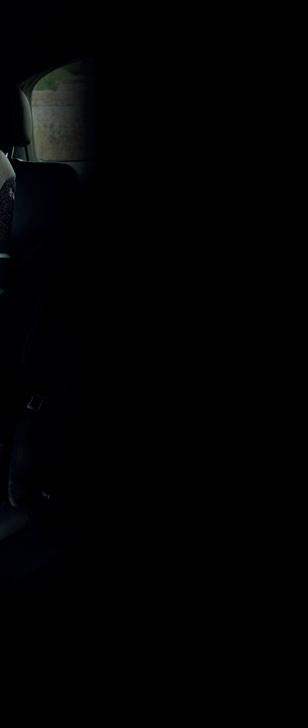
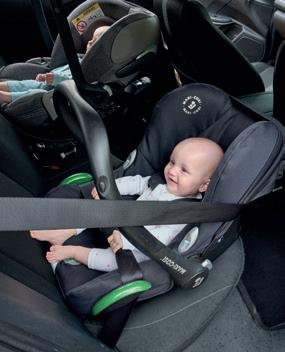
SEATBELTS
Seatbelt lengths vary, so if you’re struggling to fit a child seat with a seatbelt try it on another seat. When fitting a child seat you need to correctly follow the coloured guides. For those using an adult seatbelt the belt should go across the top of their thighs and diagonally across the chest (never behind their back or under their arm) and finally sitting on their shoulder. Teach your child to properly wear their seatbelt on every journey.
TOP TETHER

These are used to help hold the seat securely and prevent it pivoting during a crash. This is the logo for a top tether, which can normally be found on the back of the vehicle seat, the boot, the roof or the parcel shelf. Don’t confuse them with luggage hooks. Check the vehicle handbook to be sure where they are in your vehicle.
FOOT SUPPORT /LEG PROP
Some seats have a leg support which goes down to the floor of the vehicle, again to stop the seat pivoting during a crash. The prop has to make good contact with the solid floor of the vehicle. Some cars have underfloor storage and a foot support can’t be put onto the thin plastic lid of a storage box. This will do nothing to support the foot prop in the event of a crash. If you do have underfloor storage you’ll need an insert for it. If you can’t get an insert, you can’t use this type of child seat.
VEHICLE/SEAT COMPATIBILITY
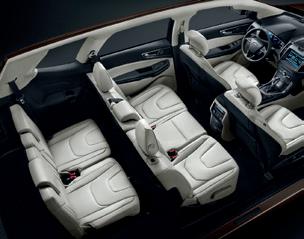
It’s essential that the child seat is compatible with the vehicle it’s going in. Also, check which seats in the vehicle can properly fit a child seat. Often there are limitations, such as with sevenseat vehicles, which sometimes can’t use the third row for child seats.

FORWARD - OR REAR-FACING?
ERF stands for Extended Rear Facing and gives you the option to keep your children rear-facing beyond 15 months. Some of these seats even take children to 36kg. In frontal impacts this is the best way to reduce the risk of neck and spinal injuries. Once in a forward-facing seat make sure the head support is still used but don’t let their eye line come above it. If it does you’ll need to adjust the height, or if you can’t you’ll need to purchase a new seat.
DON’T ADAPT
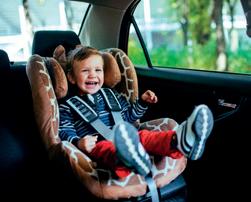
It may be tempting to alter a child seat if you think it makes it more secure or more comfortable for your child, but it won’t have been crash tested with your adjustments so there’s no guarantee it will work in a crash. This includes using head restraints to hold a child seat in place.
11 carseatsmarter.co.uk
Q A&
In
We answer the 10 most common child seat-related questions
QMy child’s seat is fitted with a seatbelt. What do I need to check for?
Check the seatbelt is tight around the seat and not twisted. Also ensure the harness isn’t twisted.
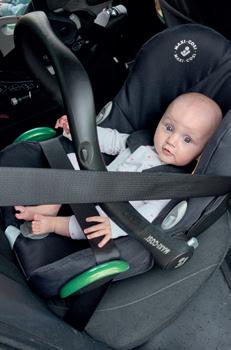
Q
How can I make sure that my child’s seat is fitted correctly?
Check the instruction manual that came with the seat and the vehicle handbook. Just remember that not all child seats fit all cars.
QWhy does the seatbelt cut into my child’s neck?
It mustn’t do this; it should sit on their shoulder and across their hips rather than their tummy. One of the advantages of a high-back booster is that it has a guide to position the diagonal belt correctly, as well as giving them upper body protection.

QHow do I know which way the seatbelt is supposed to go?
Follow the instructions on the side of the seat. These guides will be green or in older seats red for forward facing or blue for rearward facing seats.
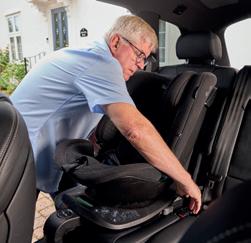
12 carseatsmarter.co.uk PARENTS GUIDE
association with childseatsafety.co.uk
QWhat are the locking clips for on the sides of my seat?
They are there to hold the seatbelt in place and make it secure. Most seats require only one lock to be used, but check the instructions.
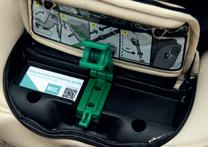
QHow can I be sure my ISOFix points are fastened?
Most have a visual indicator that changes colour when correctly attached. Don’t rely on just an audible indicator.
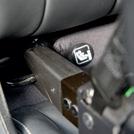
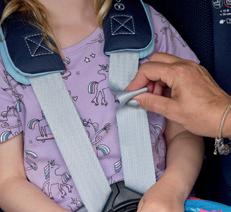
QWhat’s the pinch test?
This is the best way to check the harness is tight enough. Try to pinch the harness webbing together; if you can it’s NOT tight enough.
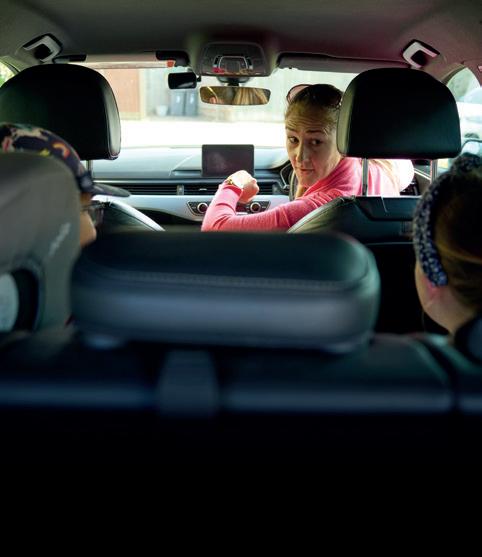
QWhy can my child escape from their harness?
Remove any thick clothes as this makes the harness less effective. For a rear-
QShould I use the tether on my seat?
Yes - If you have the fixings. Top tethers and foot supports are designed to stop the seat pivoting in a crash. Make sure they’re firmly attached to the correct position in the car. Be careful not to attach to luggage hooks or put support legs on top of underfloor storage.
facing child always have the harness level with or just behind the shoulder; no more than 2cm. For a forward-facing child always have the harness level with or just above the shoulder; no more than 2cm.
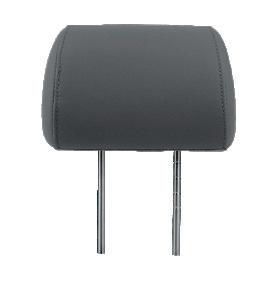

Qhead restraint in my car is pushing the child seat forward?
No - If possible remove the head restraint completely and store it safely in the boot. Don’t be tempted to use it to hold the child seat in place as it’s not designed to do that.
13 carseatsmarter.co.uk
CHILD SEAT MAINTENANCE
Your child’s car seat is going to look after them if you’re in a collision, so you must look after it. Regularly check that it’s secure by making sure the ISOFix points are locked in place or the seatbelt is still fitted in all the guides around the seat.
After carrying other passengers, check they didn’t accidentally unlock the child seat as they got
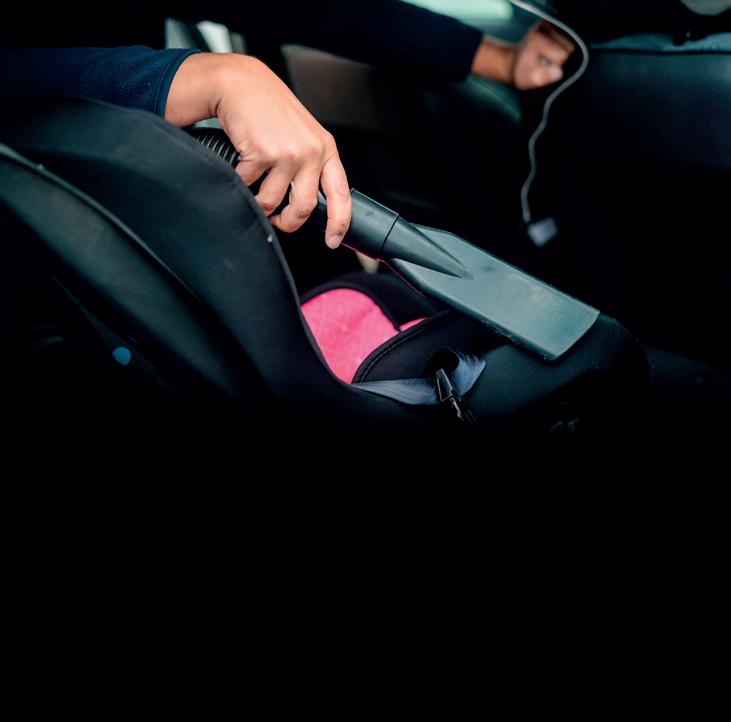
PRE-OWNED SEATS
It can be tempting to save money by using a secondhand child seat, but it’s not worth the risk. The seat probably won’t come with fitting instructions and you may not know how long it’s been used for, how it’s been cleaned, looked after, stored or if it’s been in a collision.
out, as this is easily done. Keeping the child seat clean is important, but don’t use anything more than mild soapy water on any seatbelts or harnesses. Some cleaning detergents and antibacterial sprays can burn the belts or
Wear and tear means that all child seats will eventually need to be replaced
leave a residue or coating, which could reduce their effectiveness in a collision.
Before removing the covers for washing, take photos to remind yourself how to put it back together again.
Wear and tear means that all child seats will eventually need to be replaced. If you’re in any doubt replace the whole seat. Don’t risk your child’s life.
REPLACING AFTER A COLLISION
If you’re involved in a collision, always get your child seat checked, even if your child wasn’t in it. Most manufacturers will give you advice on whether you can continue to use it or not. Some will even replace it free of charge so check their website for advice or to ask
questions. You won’t be able to tell with the naked eye, but harnesses may be stretched or plastics may be damaged. These weaken the seat’s effectiveness, so it’s usually best to replace the seat. Your Insurance should cover this as long as you were using the correct seat for the child.
14 carseatsmarter.co.uk PARENTS GUIDE
AND THERE’S MORE...
There are lots of helpful fitting videos online and some seats even have QR codes on them that will scan and provide fitting advice. Your vehicle handbookwhich is provided online if you don’t have one - has a huge amount of useful information about which child seats to use and which seats in the vehicle they can be used in.
HIRE CARS HOLIDAYS
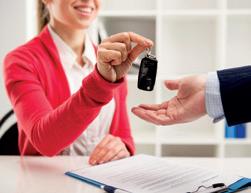

When hiring a car, check what child seat is provided. They may not fit it for you, so ask for a copy of the fitting instructions. Most manufacturers have online fitting videos or QR codes that can help you. Also, don’t be afraid to complain if you’re concerned about the quality of the seat or you suspect it may be damaged.
Laws and safety standards are not uniform across Europe. While UK law states that at 135cm tall your child can now travel using just an adult belt, some European countries stipulate that your child has to be taller. So don’t be keen to throw out their child seat when they hit 135cm because you may need it on your next holiday. Details of individual countries’ road traffic laws are available online, so read up before you travel.
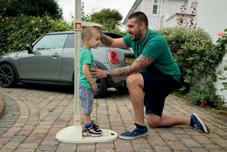
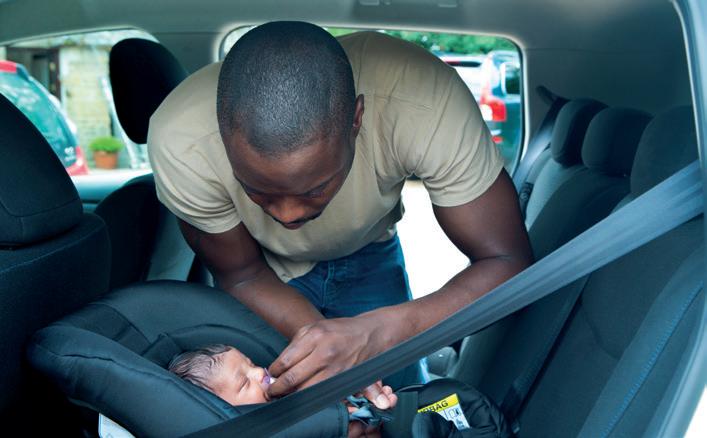
15 carseatsmarter.co.uk
Take the quiz at

This booklet tells you everything you need to know about child seats and how to use them safely. Go to the Car Seat Smarter website to put your new knowledge to the test.

Scan me
Are you car seat smart? carseatsmarter.co.uk




































